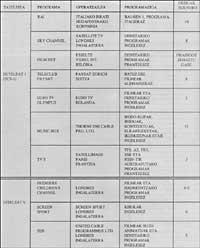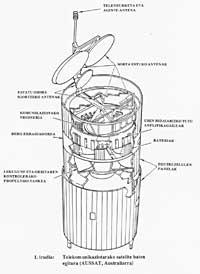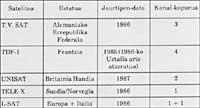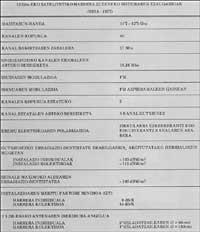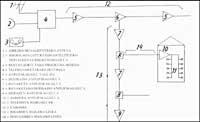Satellite television
1986/06/01 Barandiaran, Xabier Iturria: Elhuyar aldizkaria
Description
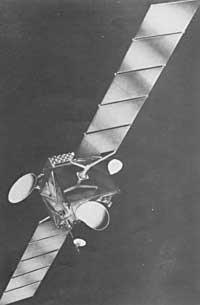
As you know, communications satellites have been used for a few years. As in the beginning the transmitters were of very low power, the satellites had to be placed in the lower orbit (10,000 Km.) so that the level of reception on Earth was adequate.
On the other hand, in order to stay in this orbit, the tangential speed of the satellite must be considerably higher than the rotation speed of the earth, so that when it is a displacement of the satellite with respect to the earth, to achieve a sustainable communication, satellites should be used. When a satellite was hidden, the receiver, through a aiming mechanism, headed to the next.
Over the years and as the technique progressed, higher power transmitters have been developed that allow the current telecommunications satellites to be placed in stationary orbits (36,000 Km from Earth).
The tangential speed required to maintain these orbits is equal to the Earth's spinning speed, so the satellite is paralyzed from the Earth. Thus, a single satellite is sufficient to illuminate a receiver throughout the day.
Geogenic satellites have been used to channel international telephone traffic and establish television links. The receivers used in these links are professional and very expensive, since the transmitter of the transmitter satellite is especially low power.
However, when the World Administrative Radio Conference (MIBA-77 or WARC-77) was held in 1977, using high-powered satellites, the basis of a broadcasting and television service was established to facilitate the reception of low-cost receivers.
There are some main reasons for using satellites. The current terrestrial television networks are based on the frequency distribution of the 1961 Stokholm agreement. This frequency distribution allows each participant only three or four national programs and technically allows the implementation of another regional program.
To be able to offer a greater number of programs a new means of transmission is necessary and at this time the satellite is the most suitable for national television distribution.
By satellite the large areas are covered regularly and also without shadows or reflections. The use of the satellite to broadcast national and international programs means that terrestrial networks will remain for regional or national programs.
Current situation
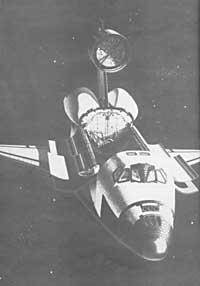
Today there are two quite different situations in the world. Some use the 4 Ghz band and some use the 11 Ghz band. All satellites that can be taken are now communication and are not intended to comply with the tele-broadcast service. Therefore, the receivers needed to receive their emissions are still quite expensive.
In the B.O.E. has developed a wide market of receivers from 3.7 Ghz to 4'2 Ghz. In fact, special broadcasting services have not been established in this country. The large number of TV channels available (125 channels of 5 different satellites) comes from low-power satellite connections between cable teledistribution companies.
In the European band of 4 Ghz you can catch two channels of the Soviet satellite GHORIZON by means of an antenna of 3 m of diameter. In this band and from the satellite INTELSAT V, the Moroccan television, in French and Arabic, can be caught with a antenna of 4'5 m and the program for the European Air Forces of the Americans, but using this antenna of 6 m.
However, the most interesting program offer of today is located in the band of 11 Ghz (10'9 to 11'7) and comes from the satellite ECS-1 (EUTELSAT-1) launched by the European Space Agency (ESA) in June 1983. Although this satellite is low power, as it was initially intended to distribute television programs to broadcasting centers, it was assigned 9 "transponders" for broadcasting. In Euskal Herria these programs can be taken with antennas of 1'8 m of diameter. In the band 11 Ghz, the satellite INTELSAT V emits up to 3 programs.
Direct Broadcast Satellite (DBS)
These satellites are designed to be sent directly to viewers, both individual and collective, so they have a power 100 times greater than those of communication and distribution. This allows the use of single-metre diameter parabolic antennas, which can be wider in the receiver specifications, which means a significant reduction in the total equipment price compared to the receiver for distribution satellites.
The direct broadcasting band is 12 Ghz, specifically 11'7 Ghz to 12'5 Ghz. The width of this band is therefore 800 Mhz and in it forty channels enter. Related information The 77 each state was assigned 5 channels and an orbital position. While distribution satellites use the PAL or SECAM system, probably Z.I satellites. use the new MAC video rule (Multiplexed Analogic Components; Multiplexed Analog Components). This standard substantially improves the quality of the video image, especially the color compared to the PAL system and also allows transmission of 8 or 4 channels of high fidelity sound.
Before 1990, five states plan to launch a satellite. The launch of the French satellite TDF-1 has been delayed several times, but the French expect to have it in orbit by June this year. Luxembourg has also explained its intention to put into orbit the satellite of 16 transponders. Although he can only use 5 channels, he can rent to another eleven countries.
On the other hand, Spain has no intention of launching the satellite, since it considers it more appropriate to rent the satellite from another State.
Structure of a satellite receiver
As can be seen in Figure 3, the receiver has two main parts: the outer unit, located on the roof, and the interior. The outdoor unit consists of a satellite dish and a converter. The converter is mounted in the antenna focus and its mission is: Lower the frequency band from 11'7 Ghz to 12'5 Ghz from 950Mhz to 1750Mhz. This is because in the coaxial cable that goes from the antenna to the indoor unit the high frequencies are very attenuated. In order to take the programs of two satellites located in different orbital positions, it is necessary to say that two antennas are needed, each with its corresponding converter and the appropriate orientation.
The signal received in the internal unit is demodulated and currently there are two options. If the installation is individual and the television has video input, the indoor unit and the TV receiver can be connected directly. But if the installation is collective, it is necessary to install reducers (one per channel) so that the signals pass to the UHF channels and that the distribution system of the collective antenna is possible.
ITT. In the coming years satellite launches will multiply, especially to cover national broadcasting services.
Observations:
"Transponder": Emits the signal you take at one frequency in another, and performs the bridge function.
1 Ghz = 1000 Mhz = 1,000,000 Khz

Gai honi buruzko eduki gehiago
Elhuyarrek garatutako teknologia




